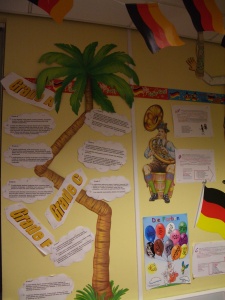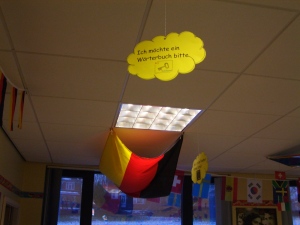Resources made by teachers, for teachers
Here you can find resources which have been made by teachers working with the principles. Please note ownership and copyright lie with the author of the resource, not the PDC. However, the creators of all the resources you can find here have given permission for you to use, adapt, and share the resources for non-commercial purposes.
Isobel Robinson has kindly shared the attached materials. She says: ‘The “Finde jemanden” document is for year 7. They each have a list and go round the class trying to find a person who says “ja” to one or two of their questions. Once someone says “ja” they write that person’s name next to the question/ statement. They are only allowed to ask the same person a maximum of 2 questions before moving on. Put a time limit of 6 or 7 minutes on”.
Also working on spontaneous speech, Maria Gomez writes “I used this powerpoint “Los ratos libres” to encourage spontaneous speech. I used the first slide with many different classes and topics to encourage my students to recall the language I had taught them the previous lesson. Slide 4 is a differentiated role-play template where students change at least the underlined words and I encourage to change more”.
Chantal Percival writes that she uses these resources (je peux parler en anglais cards, je dois parler en francais cards, ich muss auf Deutsch sprechen cards, ich darf auf Englisch sprechen cards) to encourage spontaneous talk. Learners are given a few tokens at the start of a lesson saying (in TL) ‘I must speak in French, German, Spanish, etc.’, and just one saying ‘I may speak in English’ (in TL). They have to ‘spend’ them as they use the TL in class and not hold any by the end of the lesson – so to encourage spontaneous speaking.
Magali Butler sent us this document for teaching the weather: ‘I attach two slides which have proved very popular with my Yr4s. They also tick quite a few of the learning objectives from the new MFL KS2 NC. The first one is from atantot.com which pupils need to piece together to make it rhyme. The second is my own go at creating a song on the weather. After initial warm-up practice as a class (using the tune of “Frère Jacques”), pupils could be challenged to learn it in pairs to see who could give the best/most accurate rendition. A follow-up activity could be to ask them to create their own version, changing some/all of the weather conditions.
This next resource is a song “L’éléphant Se Douche, Douche, Douche” which ties in with our work on GPCs and decoding. The “OU” sounds are highlighted. It also ticks the “songs and rhymes” box of the POS from the new National Curriculum for Key Stage 2! Feel free to use as it is or adapt.
Working on sound-spelling issues at Key Stage 2, especially silent letters in French, Emily comments: “The unit I’ve been covering with Year 4 recently is ‘Birthdays’. This powerpoint “Les mois” that I’ve put together covers three lessons in which I’ve tried to develop from learning single month words through to a sentence with emphasis on grammatical knowledge. We are now learning numbers 1-31 with the end aim of asking and saying when our birthdays are and how many children have birthdays in January etc. Colour is used to highlight the silent letters and the classes have responded really well to it”.
A number of teachers have sent in resources for reading and Principle 5. Secondary teachers sent in resources using literary or other challenging texts, with Katie Brandist generously sending in a whole series of materials to exploit French poetry (with examples she has also used with Year 6 learners). You can download the zip file here and a document that was left out of the zip file here. Three of the documents in the zip file are for Notebook. If you need them in Powerpoint form, they are below:
Maria Gomez-Ostrowski shared this Spanish resource based on a fable, which she used to aid learners’ understanding of the preterite in Spanish: Enjoying a Fable and Enjoying a Fable – answers
For German, Julie Baxter sent in a text on Prince Harry and drugs, which she has used to teach and practise reading strategies with learners.
Emmanuelle Chaubard sent in an outline for using Savoir Aimer by Florent Pagny, both as a poem and as a song. This Florent Pagny blanks document can be used with it.
Sent in by Belinda King, primary French and Spanish teacher, St John’s Catholic Primary School, Bath, and Peasedown St John Primary, Somerset: Higher level reading texts in French and Spanish for KS2
KnightsTale Reading Text in Spanish
Sent in by Louise Crossley, Royds School Specialist Language College, Oulton, Leeds (French, but could be adapted for other languages): Powerpoint for a lesson to work on improving intonation in French
Intonation and Feedback in French
Sent in by Adele Stone, Cheslyn Hay Sport and Community High School (German, but could be adapted for other languages):
Classroom language phrase sheets
Speech bubbles to hang from classroom ceiling
Adele’s ‘Learning Trees’:
Adele’s Classroom with speech bubbles- TL one side, English other side
Sent in by Sarah Normington, Gosford Hill School (German, but could be adapted for other languages):
The last item was created as a SMART Notebook but had to be converted to PowerPoint so it would upload here- unfortunately the whizzy features are lost. Still, a cracking resource!
Sarah’s reading and writing strategy wall displays:
Sent in by Marco Talevi, European School, Culham:
Students build on their oral interaction skills by giving presentations about one minute films (suitable for all languages):
Sent in by Nickey Brown, Sheffield Hallam University PGCE MFL course:
Nickey’s trainees did activities using the cards in the document below to think about strategies across all four skills and consider which of them they could incorporate into their teaching. They also played an ‘Articulate’ style game to highlight strategies used when you don’t know a word.
Sent in by David Spence, Bristol Metropolitan Academy (French):
David used these materials to work on reading comprehension strategies with his students.
La lutte sénégalaise – longer reading text for Principle 5
Reading Strategies Log for Year 9 – strategies for approaching a longer reading text
Languages Attitudes Survey for Year 9
Sent in by Julie Howarth, Great Wyrley Performing Arts High School, Walsall: Julie used these to develop her students’ oral interaction skills (see Principles 1 – 4).
Classroom language reference sheet French
Reward grid for speaking in target language
Alex von Widdern, Abingdon School, made this reading strategies prezi, which she used with year 9:






